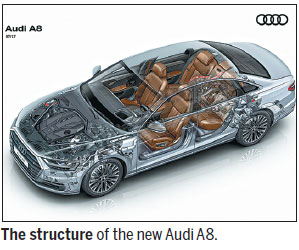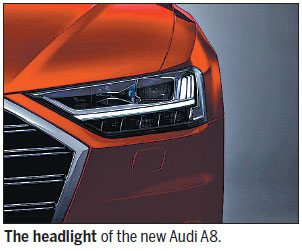New Audi A8 set to pave way for new world of automated driving
The world's first production car allowing conditional automated driving on China's public roads will transform the future into immediate reality on the streets, says its maker.
For the first time, drivers will be able to completely hand over their driving tasks to their vehicle, in certain situations.
The star car that will perform this technological feat is the new Audi A8, backed by the premium carmaker's revolutionary technology, which is set to launch soon in the world's single biggest auto market.
|
The new Audi A8 is the first series-production automobile in the world to drive in an automated manner in traffic situations. Photos Provided to China Daily |
Audi says its new car has achieved a technological milestone that was preceded by many years of research and development work.
Equipped in the latest premium sedan - which redefines "Vorsprung," or progress, right across the board - the new Audi Artificial Intelligence traffic jam pilot system allows for highly automated driving at level 3, which is classified as partial automation that is only two steps away from the full automation of level 5.
Vehicles at level 3 can make decisions themselves, and are considered to be automated driving systems. They can monitor the driving environment around them.
Audi says it is worth noting that such a system represents one of the top innovations of the brand which no other competitor offers.
The level 3 automated driving is defined as: in certain situations, the car takes over the task of driving. During this time, the driver no longer has to permanently survey all processes - contrary to level 2.

The Audi AI traffic jam pilot system takes charge of driving in slow-moving traffic up to 60 km/h (37.3 mph) on freeways and highways where a physical barrier separates the two carriageways.
The system is activated using an AI button on the central console. In addition, the traffic jam pilot can handle the full range of driving tasks - starting, acceleration, steering and braking.
When certain conditions occur, the driver can take their hands of the steering wheel until the car requires manual driver control again and, depending on the national laws, focus on a different activity that is supported by the car, such as watching on-board TV.
As soon as the system reaches its limits, it calls on the driver to take back driving control. As a result, the driver only needs to be in a position to resume control once he or she is requested to do so.
The rule-based application of driving assistance systems - such as active lane assist, adaptive cruise control or the predictive efficiency assistant - has already made driving safer, more comfortable and more efficient in the past few years.

The new Audi A8 is the first production car in the world to fulfill the technical requirements to drive upon request in a highly automated manner within a variety of traffic situations. The core of the system that Audi is developing for piloted driving is the central driver assistance system control unit, or zFAS.
As the first system presented in the world, the Audi AI traffic jam pilot in the new Audi A8 is an example of how vehicle intelligence looks today. Ultrasound and radar sensors, laser scanners, camera-based systems, a high-performance processor for data processing and a rapid internet connection via the mobile phone network are all features that the new Audi A8 has on-board.
Self-learning AI
The mastermind makes its debut in the new Audi A8. Audi AI systems are capable of learning and thinking, while also being proactive and personal. Thanks to Audi AI, models bearing the four rings will be both intelligent and empathetic. They will be able to continually interact with their surroundings and the vehicle occupants, and thus adapt themselves in a better way than ever before to the individual requirements of those on board.

A comprehensive collection of sensors takes in the surroundings. The data from these is then computed in the central vehicle assistance control unit, which celebrates its debut in the new Audi A8. This continually delivers a map of the surroundings and is supported by means of a second data fusion in the radar control unit.
One of the most significant fields in the application of machine learning is currently object and environment recognition. In the Audi A4, A5, Q5 and Q7 models, object recognition has already been implemented with the help of supervised learning. For this purpose, a training system is used and as a result, the learning process is complete before the car goes into mass production.
Even in the new Audi A8, supervised learning is used for object recognition as well. Image processing developed by the German group's technology partner Mobileye is based, among other things, on this deep learning method. Audi says this involves deep neural networks being trained, using various data sets. In this way, the neural network learns to classify a diverse range of objects - as cars, as cyclists and as pedestrians. The data retrieved as part of this process is then made available to the final version of the driver assistance system software, as well as to that of piloted driving. Because of this process, the new Audi A8 therefore also detects free space in which it can drive. This is a major requirement for the new Audi AI traffic jam pilot.
Extensively networked, automated and electrified - these characteristics define the Audi of the future.
Audi AI will soon be the cipher for a variety of innovative systems which will relieve strain on the driver and simultaneously also offer him or her new possibilities to utilize the time spent in the car.
To this end, with its stylistically defining design, top-rate suspension solutions, touchscreen operating concept and electrification of all drive systems, the fourth generation of the Audi A8 is considered to be heading the way forward into a new era.
Audi AI also uses strategies and technologies from the field of and machine learning. Audi says this puts the brand well ahead of its competitors.
haoyan@chinadaily.com.cn
(China Daily 10/23/2017 page19)















